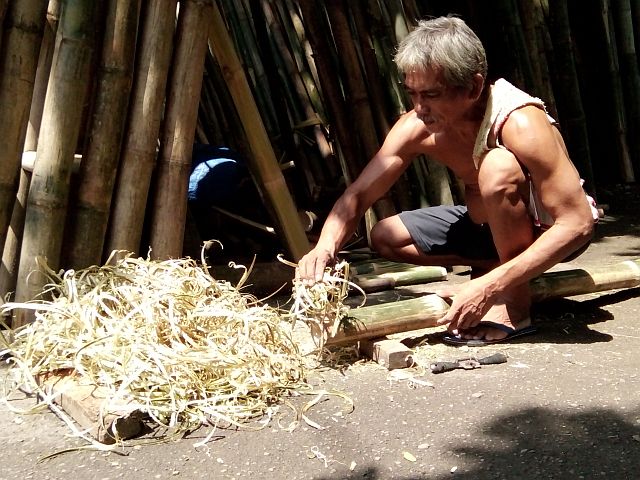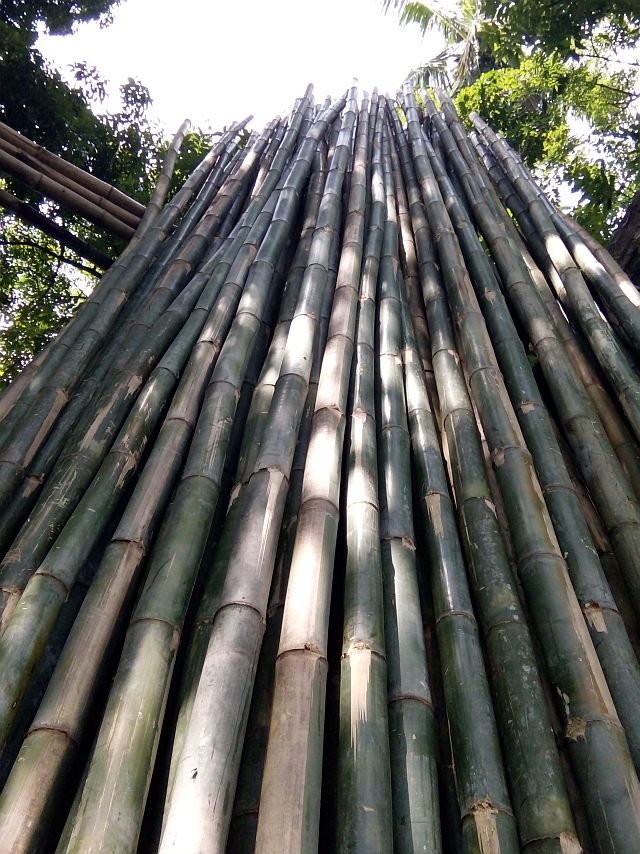
Nestor Lapaz has been transforming ordinary bamboo into furniture pieces along Gorordo, Cebu City for more than 30 years( CDN PHOTO/MOREXETTE ERRAM).
Once a week, before a streak of sunlight touches the asphalt sidewalk of Gorordo Avenue, a mini-bus unloads more than 30 freshly harvested poles of bamboo from Cebu City’s hillside barangays Bacayan, Sirao and Talamban on the pavement.
A single truckload of bamboo poles cost P15,000 according to Nestor Lapaz, a 58-year-old furniture maker doing business at a lot right beside the University of the Philippines College Cebu (UPCC)in Barangay Lahug.
Back when his body could still endure long walks and carry heavy loads, Lapaz traveled to the woodlands surrounding Ayala Heights in the upper portion of Barangay Busay to harvest bamboo poles himself.
But the plants no longer flourish within the city proper, he said.
So he gathers his supplies from the hilly terrains of Barangays Sirao and Talamban, particularly from the banks of small streams and rivers like the Butuanun River.
“It’s a type of grass that grows everywhere. Harvesting it is a hard task, and it’s risky,” Lapaz, a father of two, said.
“If you’re not a bamboo expert and you try to cut one pole, you may cut your palms open. Before you cut it, you must clear the thorns lying around its roots and cut away the leaves,” explained Lapaz in Cebuano.
On the early afternoon of September 25, Cebu Daily News chanced upon Lapaz cutting a 30-foot high bamboo pole into seven small pieces which were to be used as flooring for one of his clients’ bamboo huts.
Lapaz has been working as a carpenter for more than three decades, since 1984 when he was only 19.
He learned the skills from watching his father build furnishings from wood way back when there were only three carpenters with bamboo-furniture shops along Gorordo Avenue.
“There are days when no one actually buys any of our products. There are also rare times when some of our clients ask and pay us to make a particular piece. But the income we got was enough to provide our daily needs and to keep the family business afloat,” said Lapaz.
A bamboo sala-set, composed of two arm chairs, a coffee table and a long bench, costs P3,500.
If bought individually, each armchair costs P1,000 and the bench at P1,800.

Piles of bamboo, bought from growers in the hillylands of Barangays Bacayan, Talamban and Sirao, Cebu City, stand proudly by the road (CDN PHOTO/MOREXETTE ERRAM).
If there’s one problem he finds in today’s bamboo industry, Lapaz cited the decline in quality-made bamboo furniture and products.
For a bamboo carpenter and harvester like him, Lapaz classifies two types of bamboo furniture makers.
The first one cuts and assembles a bamboo product meticulously — leaving no shred of skin visible while bathing the poles in chemicals to drive away woodborers locally known as “bokbok”; while the other simply abandons the process and directly brushes thick, red paint to give the furniture a smooth finish.
Modern bamboo furniture
Khail Santia, co-founder of Moocho Brain Interactive Designs, a game-developing company based in Central Visayas, expressed dismay over a seeming decline in the bamboo trade.
“Despite all the known advantages of bamboo, it is a dying trade. Bamboo is still not the first choice when it comes to building our structures. There is a widespread misconception of bamboo as a material that does not endure,” said Santia, designer of a board game called Bamboard.
The Bamboard, which is purely made from bamboo, was designed to aid the teaching and learning of basic mathematics in technology-deprived schools and out-of-school youths.
It is specifically designed to integrate education and fun.
Representing his school, Silliman University, Santia — together with Queenie Maria Guibao and Cindy Lalin Bonachita — won the Benilde Prize for Design Excellence in March 2015 for their Bamboard Project.
Producing the Bamboard project, he said, will boost the livelihood of bamboo craftsmen in Dumaguete City and those found on the foothills of Mount Talinis which is the second highest mountain in Negros Oriental.
Santia also created a table called Sungkawayan, inspired by two fading concepts: bamboo and the native Mancala game, Sungka.
The Sungkawayan can be used as a simple set of furniture; or while sitting on one of the seven-inch stools people could actually play sungka on the table’s surface.
In an essay, Santia said that a single pole of freshly cut bamboo can be sold for 40 pesos in Dumaguete City — sufficient to keep a farmer’s child in school for two days or “a day’s worth of rice” for his family.
“13 million hectares of forest are lost each year, equivalent to 48 football fields every minute. Bamboo can be a substitute for wood for nearly every application . . . Hard bamboo can be harvested in five years while hardwoods like teak can take 20 to 25 years,” he said.
“Bamboo is grass — it can flourish in a wide variety of conditions without the need for special care or agricultural chemicals . . . and it is the fastest natural method to sequester carbon from the atmosphere, releasing 35 per cent more oxygen than an equivalent stand of trees,” he added.
Disclaimer: The comments uploaded on this site do not necessarily represent or reflect the views of management and owner of Cebudailynews. We reserve the right to exclude comments that we deem to be inconsistent with our editorial standards.
